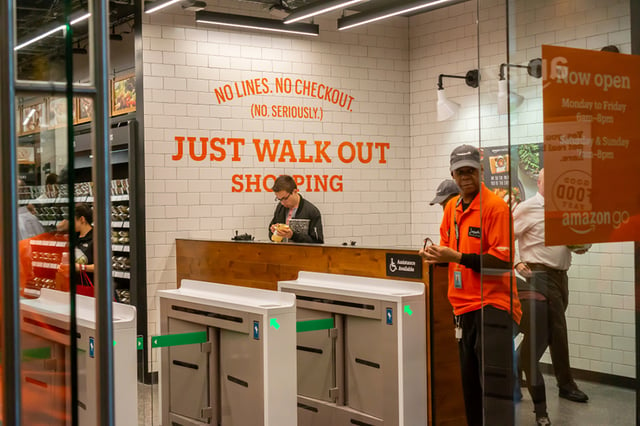Winning the Grocery Digital Transformation Game
Retailers in the grocery space all know that innovation is the name of the game to win in today’s increasingly digital-first environment. If grocers want to meet the demands of their customers, they have to adapt.
However, the integration of new channels and technologies in the grocery space is sometimes easier said than done. As grocers make their way through the industry’s competitive landscape, they face a slew of these types of obstacles on their way to innovation, but, if they use their POS game piece effectively, they can ultimately win at the digital grocery game.
Fulfillment Options Limited by Legacy Technology
The big challenge, particularly for major grocers, is deciding what range of purchasing and fulfillment options should be offered without alienating new and existing customers. When retailers consider the range of options available (staffed till, self-checkout, scan-and-go, click-and-collect, home delivery, frictionless baskets, frictionless carts, etc.), it’s essential that they take time to trial and test their preferred options before making a hefty investment.
As grocers begin to analyze and plan new fulfillment implementations, it’s immediately evident that these decisions are not only complex, but also heavily influenced by legacy technology capabilities and the substantial costs associated with implementing these new solutions.
On-Site Fulfillment Versus Off-Site Fulfillment
With online order fulfillment, grocers are weighing the options of investing in automated on-site fulfillment versus an off-site high-tech warehouse approach.
On the one hand, investing in an off-site high-tech warehouse enables retailers to promote long-term growth and expansion by allowing more space for inventory. For example, Kroger’s partnership with leading online supermarket Ocado to build a high-tech customer fulfillment center has enabled the company “to accelerate its ability to provide customers with anything, anytime and anywhere.” The Kroger-Ocado partnership has digital and robotic capabilities that will help ramp up operations and accelerate growth in grocery ecommerce.
However, the high cost for more space, technology and employees may be out of reach for many retailers. That’s why other grocers are investing in automated on-site fulfillment instead, which gives them the ability to have all inventory in one place, saving additional facility costs. The on-site fulfillment inventory approach potentially gives retailers the advantage of shortening lead time for fulfilling orders. With so many competing factors, it will take careful consideration to determine what’s right for each unique business need.
Growth of Experiential Shopping
A major recent shift in grocery is the growth of experiential shopping. The ability to provide personalized and fun experiences beyond traditional grocery shopping enables grocers to build increased brand loyalty and upsell more products and services while the customer is on-site.
One of the biggest pioneers in experiential shopping is Alibaba, which has created a chain of offline retail stores, Hema, to bridge the gap between online and offline shopping. For example, customers using Hema’s mobile app can scan an item’s barcode on their smartphones and receive product information and recipe ideas. To build on the in-store experience, Alibaba also recently introduced a restaurant connected to a Hema store, where food is ordered entirely through an app and delivered by robots. These experiences have garnered attention worldwide, as Alibaba and Hema influence a shift toward experiential shopping in the United States, even from 6,000 miles away.
Following in these footsteps, Texas grocer H-E-B has revealed plans to renovate an existing store with a beer garden, live music, underground parking and even a food hall, all in the name of creating the best and most lasting customer experience. Wegmans Food Markets has also transformed its stores into experiential destinations, featuring bookstores and dry cleaners not typically found in supermarkets.
POS as Common Denominator
In all of these strategic decisions, the point of sale is a common denominator. Grocers will need to host a variety of point-of-sale options to support both fulfillment requests and experiential shopping. Whether these requests come from a fixed register, in the aisle, on a scan-and-go cart, in an outdoor beer garden/restaurant, on a mobile app or simply an online order, grocers need to ensure that the transaction process is standardized across all stores, and ideally processed within the store environment to simplify account tracking. This provides both consistency of experience for the customer and true endless-aisle flexibility.
To achieve seamless online-offline integration isn’t simple, which is why virtualization at the retail edge – in the actual stores – is increasingly being explored. The reality is that more and more workloads will be required to run locally to provide the levels of secure, scalable technology required for efficient order fulfillment and fast transaction performance.
Virtualizing both front-of-store POS applications and back-of-store technology will meet the needs of the modern grocery store. Employees can quickly check out and fulfill customer orders across multiple devices, and customers can place orders across multiple channels, while the back-office IT runs all of these workloads efficiently with minimal manual intervention, resulting in less time spent on support and maintenance.
As grocers navigate the transformation to frictionless, convenient and interactive shopping experiences, they need to understand how virtualization of all store applications, including the POS system, can be the key foundation to driving digital transformation and delivering a platform for rapid innovation.







